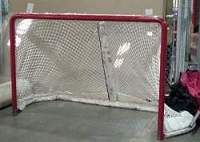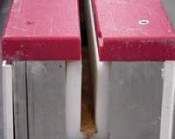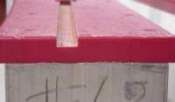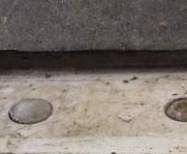Rink Logistics
Since the Raleigh arena is home to the Carolina Hurricanes, the rink must meet all NHL regulations. This includes shape and size requirements, surround requirements, maintenance requirements and temperature requirements. Even during non-hockey events, the rink must be properly maintained.
Even during most non-skating events, the ice is always there. MacMillan explains that the conversion process is fairly complex. "For NC State basketball games, we make an ice deck using 4-by-8 sheets of plywood to cover the ice. Then we put the basketball floor over that. For non-hockey shows, we also take down the glass surrounding the rink. It takes six to eight hours to change from the ice rink to the basketball court." MacMillan says the ice is only broken up and hauled out "for the circus, because they make points in the floor to hold the trapeze and other things, or for a truck pull."
Advertisement
Rink Shape & Size
Rink Shape & Size

An official NHL rink measures 200 feet (61 m) in length and 85 feet (26 m) in width, with corners rounded to a 28-foot (8.5-meter) radius. The end zone width is 11 feet (3.4 m), and the zone between the center blue lines is 50 feet (15.2 m).
For hockey purposes, the rink has various painted markings (we'll discuss paint in detail later), as shown in the image below. These images include the goal lines and creases, blue lines, red center line, face-off circles, and face-off spots -- each of these must be carefully measured to fit within that 200-foot by 85-foot space. The goal net is 4 feet (1.2 m) high and 6 feet (1.8 m) wide, and is only 44 inches (112 cm) deep.

Rink Surrounds
The NHL Rulebook dictates that for hockey games, the rink is surrounded with boards above the playing surface and glass above the boards.

The boards are a continuous wooden or fiberglass wall, often used as advertising space. The boards sit on top of the ice surface and are ideally 42 inches (107 cm) high. Except for the official league and team markings, the entire playing surface and the boards are painted white. The kickplate at the bottom of the boards is light yellow. The boards are constructed so that the surface facing the ice is smooth and free of any obstruction or any object that could cause injury to players. The doors in front of each team's bench and the penalty box open inward, away from the playing surface, to prevent injury to players.
The glass that surrounds the rink for hockey games is very important because it protects the fans from line-drive pucks, and it protects the players from the fans. In addition to protecting the fans, players, and playing surface, MacMillan says that keeping the glass up around the rink while the floor is being flooded helps it set up faster. "It keeps the cool air in, allowing it to freeze quicker. Otherwise, all the cool air floats out into the seats."
There are two types of glass:


- Tempered glass - The sides of the rink (as well as the team benches and penalty boxes) are lined with seamless, tempered glass. Although the primary purpose of the tempered glass is to provide an unobstructed view for the fans, it can also better withstand the force of a player or a slap shot slamming into it. Tempering is an annealing process, involving successive heating and cooling, and makes glass harder and less brittle. The pieces of side glass, each 6 feet tall and 5/8 of an inch (1.6 cm) thick, fit together smoothly.
- Plexiglas - The ends of the rink are lined with Plexiglas -- acrylic plastic sheets. The end glass is 8 feet (2.4 m) tall and a 1/2 inch (1.3 cm) thick. The Plexiglas sheets are fitted together with supports that are mounted on the outside edge of the boards, so they don't interfere with play.
According to MacMillan, many players -- if they had to choose -- would rather be checked against the Plexiglas than the tempered glass. "Because the Plexiglas is held together by supports, it gives a little more than the tempered glass does."
